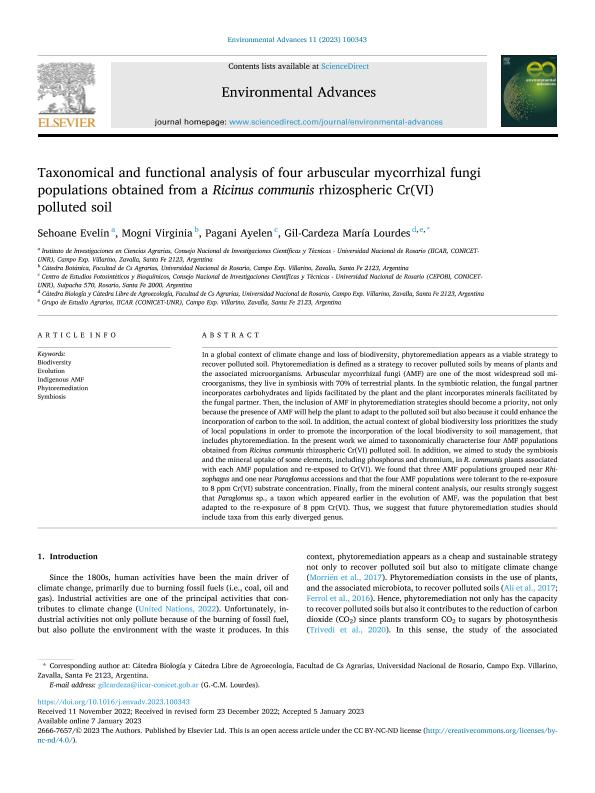Mostrar el registro sencillo del ítem
dc.contributor.author
Sehoane, Evelin Noelia

dc.contributor.author
Mogni, Virginia Yanina

dc.contributor.author
Pagani, María Ayelén

dc.contributor.author
Gil Cardeza, Maria Lourdes

dc.date.available
2024-01-26T13:28:21Z
dc.date.issued
2023-04
dc.identifier.citation
Sehoane, Evelin Noelia; Mogni, Virginia Yanina; Pagani, María Ayelén; Gil Cardeza, Maria Lourdes; Taxonomical and functional analysis of four arbuscular mycorrhizal fungi populations obtained from a Ricinus communis rhizospheric Cr(VI) polluted soil; Elsevier; Environmental Advances; 11; 4-2023; 1-11
dc.identifier.issn
2666-7657
dc.identifier.uri
http://hdl.handle.net/11336/224966
dc.description.abstract
In a global context of climate change and loss of biodiversity, phytoremediation appears as a viable strategy to recover polluted soil. Phytoremediation is defined as a strategy to recover polluted soils by means of plants and the associated microorganisms. Arbuscular mycorrhizal fungi (AMF) are one of the most widespread soil microorganisms, they live in symbiosis with 70% of terrestrial plants. In the symbiotic relation, the fungal partner incorporates carbohydrates and lipids facilitated by the plant and the plant incorporates minerals facilitated by the fungal partner. Then, the inclusion of AMF in phytoremediation strategies should become a priority, not only because the presence of AMF will help the plant to adapt to the polluted soil but also because it could enhance the incorporation of carbon to the soil. In addition, the actual context of global biodiversity loss prioritizes the study of local populations in order to promote the incorporation of the local biodiversity to soil management, that includes phytoremediation. In the present work we aimed to taxonomically characterise four AMF populations obtained from Ricinus communis rhizospheric Cr(VI) polluted soil. In addition, we aimed to study the symbiosis and the mineral uptake of some elements, including phosphorus and chromium, in R. communis plants associated with each AMF population and re-exposed to Cr(VI). We found that three AMF populations grouped near Rhizophagus and one near Paraglomus accessions and that the four AMF populations were tolerant to the re-exposure to 8 ppm Cr(VI) substrate concentration. Finally, from the mineral content analysis, our results strongly suggest that Paraglomus sp., a taxon which appeared earlier in the evolution of AMF, was the population that best adapted to the re-exposure of 8 ppm Cr(VI). Thus, we suggest that future phytoremediation studies should include taxa from this early diverged genus.
dc.format
application/pdf
dc.language.iso
eng
dc.publisher
Elsevier

dc.rights
info:eu-repo/semantics/openAccess
dc.rights.uri
https://creativecommons.org/licenses/by-nc-nd/2.5/ar/
dc.subject
BIODIVERSITY
dc.subject
EVOLUTION
dc.subject
INDIGENOUS AMF
dc.subject
PHYTOREMEDIATION
dc.subject
SYMBIOSIS
dc.subject.classification
Micología

dc.subject.classification
Ciencias Biológicas

dc.subject.classification
CIENCIAS NATURALES Y EXACTAS

dc.title
Taxonomical and functional analysis of four arbuscular mycorrhizal fungi populations obtained from a Ricinus communis rhizospheric Cr(VI) polluted soil
dc.type
info:eu-repo/semantics/article
dc.type
info:ar-repo/semantics/artículo
dc.type
info:eu-repo/semantics/publishedVersion
dc.date.updated
2024-01-25T13:57:19Z
dc.journal.volume
11
dc.journal.pagination
1-11
dc.journal.pais
Países Bajos

dc.description.fil
Fil: Sehoane, Evelin Noelia. Consejo Nacional de Investigaciones Científicas y Técnicas. Centro Científico Tecnológico Conicet - Rosario. Instituto de Investigaciones en Ciencias Agrarias de Rosario. Universidad Nacional de Rosario. Facultad de Ciencias Agrarias. Instituto de Investigaciones en Ciencias Agrarias de Rosario; Argentina
dc.description.fil
Fil: Mogni, Virginia Yanina. Universidad Nacional de Rosario; Argentina. Consejo Nacional de Investigaciones Científicas y Técnicas. Centro Científico Tecnológico Conicet - Rosario; Argentina
dc.description.fil
Fil: Pagani, María Ayelén. Consejo Nacional de Investigaciones Científicas y Técnicas. Centro Científico Tecnológico Conicet - Rosario. Centro de Estudios Fotosintéticos y Bioquímicos. Universidad Nacional de Rosario. Facultad de Ciencias Bioquímicas y Farmacéuticas. Centro de Estudios Fotosintéticos y Bioquímicos; Argentina
dc.description.fil
Fil: Gil Cardeza, Maria Lourdes. Consejo Nacional de Investigaciones Científicas y Técnicas. Centro Científico Tecnológico Conicet - Rosario. Instituto de Investigaciones en Ciencias Agrarias de Rosario. Universidad Nacional de Rosario. Facultad de Ciencias Agrarias. Instituto de Investigaciones en Ciencias Agrarias de Rosario; Argentina
dc.journal.title
Environmental Advances
dc.relation.alternativeid
info:eu-repo/semantics/altIdentifier/doi/http://dx.doi.org/10.1016/j.envadv.2023.100343
Archivos asociados
